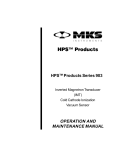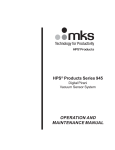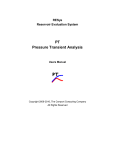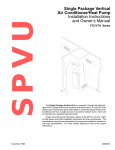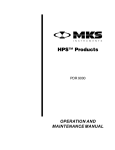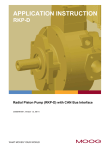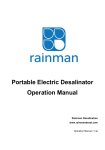Download HPS 907 Operation/Maintenance Manual
Transcript
HPS® Products Series 907 Analog Convection Transducer (ACT) Vacuum Sensor OPERATION AND MAINTENANCE MANUAL HPS® Products Series 907 ACT Analog Convection Transducer (ACT) Vacuum Sensor SEPTEMBER 1999 PART # 109070001 REV. A1 Analog Convection Transducer (ACT) Vacuum Sensor Part # 1090700XX or 1090700XXCE __ __ __ __ Please fill in this number and have it readily available when calling for service or additional information. (The part number can be found on your packing slip.) For more information or literature, contact: MKS Instruments, Inc., HPS® Products, Inc. 5330 Sterling Drive Boulder, CO 80301 USA Phone: 303-449-9861 800-345-1967 FAX: 303-442-6880 © 1995, 1996 by MKS Instruments, Inc., HPS® Products, Inc. ll rights reserved. trademark of MKS Instruments, Inc., HPS® Products, Inc. Teflon and Viton are registered trademarks of DuPont Co. VCR® is a registered trademark of Swagelok® Company. Analog Convection Transducer (ACT) Vacuum Sensor Table of Contents Table of Contents Package Contents ..................................................................... 1 Symbols Used in this Manual .................................................... 2 Safety Precautions .................................................................... 3 Specifications ............................................................................ 4 Feature and Control Locations .................................................. 6 Typical Applications for the Series 907 ACT ............................. 7 About the HPS® Products Series 907 ACT ................................ 8 Installing the Series 907 ACT .................................................... 9 Location ................................................................................................... 9 Orientation ............................................................................................... 9 Contamination ......................................................................................... 9 Vacuum Connection ................................................................................ 9 Electrical Connection .............................................................................10 Input/Output Wiring ................................................................................. 10 Relay Inductive Loads and Arc Suppression .......................................... 12 Operating the Series 907 ACT ................................................ 13 Reading Pressure ...................................................................................13 Calibrating for Zero and Atmosphere ...................................................... 14 Adjusting the Set Point ........................................................................... 15 Venting to Atmosphere ........................................................................... 15 Leak Detection ....................................................................................... 16 Using the Series 907 ACT with Other Gases .......................... 17 Nitrogen Equivalent Pressure .................................................................17 Calibrating for Other Gases ....................................................................18 Using the Series 907 ACT with Computers ............................. 19 Analog-to-Digital (A/D) Converter ...........................................................19 Equations for Converting Voltage to Pressure ........................................ 19 Maintaining the Series 907 ACT ............................................. 20 Troubleshooting and Service ................................................................... 20 Cleaning the ACT Case and Sensor Tube ...............................................21 Analog Convection Transducer (ACT) Vacuum Sensor Testing the ACT Sensor Tube ................................................................. 21 Replacing the ACT Sensor Tube Disassembling the ACT Electronics Subassembly ......................................................................................... 22 Calibrating the New Sensor Tube .............................................................................. 22 Assembling the ACT Electronics Subassembly ...................................................... 22 Preparing the ACT for Bake out ............................................................. 22 Accessories ............................................................................. 23 Product Warranty ..................................................................... 25 Appendix A: How the Series 907 ACT Works ......................... 26 Theory of a Thermal Conductivity Sensor ............................................... 26 Measurement Limits ............................................................................... 26 Notes ....................................................................................... 27 Analog Convection Transducer (ACT) Vacuum Sensor Package Contents Before unpacking your Series 907 Analog Convection Transducer (ACT) Vacuum Sensor, check all surfaces of the packing material for shipping damage. Please be sure that your Series 907 ACT package contains these items: 1 ACT unit (integrated sensor tube and electronics) 1 female, 9-pin [or 15-pin], subminiature D (D-sub) connector 1 HPS® Series 907 Analog Convection Transducer (ACT) Vacuum Sensor User's Manual. This manual covers both the single set point and dual set point models. When information differs for the two models, the dual set point model information will follow the single set point information in brackets [ ]. If any items are missing from the package, call HPS® Customer Service at 1-303-449-9861 or 1-800-345-1967. Inspect the ACT for visible evidence of damage. If it has been damaged in shipping, notify the carrier immediately. Keep all shipping materials and packaging for claim verification. Do not return the product to HPS®. Analog Convection Transducer (ACT) Vacuum Sensor 1 Symbols Used in this Manual The first two symbols below, that may be located on your Series 907 ACT, identify critical safety concerns. They are used throughout this manual to further define the safety concerns associated with the product. The last two symbols identify other information in this manual that is essential to highlight or useful in achieving optimal performance from the ACT. CAUTION: Risk of electrical shock. CAUTION: Refer to manual. Failure to heed message could result in personal injury or serious damage to the equipment or both. Failure to heed message could result in damage to the equipment. Information calling attention to important procedures, practices, or conditions. 2 Analog Convection Transducer (ACT) Vacuum Sensor Safety Precautions Do not use the Series 907 ACT with explosive gas mixtures or gases that are combustible in air. If the control circuit fails or an exothermic catalytic reaction occurs at the sensor platinum wire, the wire could ignite the gas mixture. When using with gases other than air or nitrogen, avoid overpressure to prevent any possibility of explosion. Since the ACT is calibrated for air/nitrogen, the measured pressure of another gas will differ from its true pressure. Calibrations diverge widely at higher pressures. Since the different gases are not linearly related, a gas correction factor could lead to hazardous overpressure. Capacitance manometers and mechanical dial gauges are best suited for higher pressures. Refer to page 17 for use with other gases. In a system which is filled with a pressurized source, install a safety relief valve or burst disc to safely limit pressure. Allow only qualified technicians to service the Series 907 ACT. Users should not remove covers, casings, or plug-in components. Injury may result. Any part replacement or internal adjustments must be performed by a qualified technician only. The Series 907 ACT must be used as instructed by MKS Instruments, Inc., HPS® Products, Inc., to ensure safe operation. Use or modification of the equipment in a manner not consistent with specifications may render the product's inherent protection useless. Analog Convection Transducer (ACT) Vacuum Sensor 3 Specifications Measuring Range 1.0 x 10-3 to 1.0 x 10+3 Torr 1.3 x 10-3 to 1.3 x 10+3 mbar 1.3 x 10-1 to 1.3 x 10+5 Pa Useful Set Point Range 5.0 x 10-3 to 1.0 x 10+3 Torr 6.5 x 10-3 to 1.3 x 10+3 mbar 6.5 x 10-1 to 1.3 x 10+5 Pa Calibration Gas Air/nitrogen Operating Temperature Range 0° to 40°C (32° to 104°F) Maximum Bakeout Temperature 200°C (392°F) or 100°C (212°F) CE marked model; without electronics Relative Humidity 80% maximum for temperatures less than 31°C, decreasing linearly to 50% maximum at 40°C Altitude 2000 m maximum Insulation Coordination Pollution Degree 2 Controls 1 or 2 nonvolatile, independent relay set points; atmospheric adjustment; zero adjustment Relay Contact Rating SPDT, 1 A @ 24VAC/DC, resistive Relay Response 150 msec maximum Power Requirement 12 to 30 VDC, 0.2 A Output Voltage 0.38 to 5.66 VDC, 1 k9 maximum output impedance Installation Orientation Horizontal only Internal Volume 2.0 in.3 (33.0 cm3) maximum Materials Exposed to Vacuum 304 stainless steel, platinum, glass, nickel Display LED indicators for set points and power Electronic Casing ABS Plastic (with conductive coating for CE marked model) 4 Analog Convection Transducer (ACT) Vacuum Sensor Casing Dimensions (W x D x H) 4½" x 1¾" x 2¾" (114 mm x 44 mm x 71 mm) Typical Weight (with KF Flange) 0.7 lb (0.3 kg) Vacuum Connection KF 16 KF 25 1 /8" NPT-M with ½" compression seal option 8 VCR®-F (½") 11/3" CF (non-rotatable) 2¾" CF (non-rotatable) Ø 15.0 mm x 30.0 mm tubing Ø 18.0 mm x 30.0 mm tubing CE Certification EMC Directive General Product Safety Directive Design and/or specifications subject to change without notice. Analog Convection Transducer (ACT) Vacuum Sensor 5 Feature and Control Locations 1 2 3 4 5 6 7 8 9 10 11 12 13 14 6 Tip Jack for Common [LED Set Point 2 Indicator] LED Set Point 1 Indicator [Tip Jack for Set Point 2] [Set Point 2 Adjustment Potentiometer] Set Point 1 Adjustment Potentiometer Zero Adjustment Potentiometer Tip Jack for Output Tip Jack for Set Point 1 LED Power On-Off Indicator Atmospheric Adjustment Potentiometer Male, 9-pin [15-pin] D-sub Connector Screws (Access to Sensor) Sensor Vacuum Port Analog Convection Transducer (ACT) Vacuum Sensor Typical Applications for the Series 907 ACT Measuring fore line and roughing pressures generated by mechanical vacuum pumps Controlling valves and pumps to automate system pump down using the relay set point(s) Sensing abnormal pressure and taking appropriate security measures using the relay set point(s) Controlling system pressure using the analog output as input to an automatic pressure controller Starting or stopping system processes using the relay set point(s) Measuring pressures of backfilled gases in the range of 10-3 to 10+3 Torr Activating high vacuum gauges in their operating range Analog Convection Transducer (ACT) Vacuum Sensor 7 About the HPS® Products Series 907 ACT The HPS® Products Series 907 Analog Convection Transducer (ACT) is a compact, modular, convection enhanced Pirani vacuum sensor/pressure switch with an integrated electronic control circuit. The ACT’s simple modular design, high reliability, and low cost make it especially attractive to OEM equipment manufacturers. It has an integrated sensor tube, available with one of various standard vacuum interfaces. The ACT is designed for applications which require pressure control in the range of 10+3 to 10-3 Torr. Its rapid response and wide measurement range provide the equipment designer with maximum flexibility. Because it can operate autonomously or as part of a control system, it is adaptable to many roles, including that of a monitor or an alarm. For process control, the ACT is available with one or two relay set points, each independently adjustable with its own potentiometer. LEDs indicate the status of the set points. The ACT can be located out of sight — pressure and set points are then read with a standard digital voltmeter or analog-to-digital converter and computer. 8 Analog Convection Transducer (ACT) Vacuum Sensor Installing the Series 907 ACT Location Locate the ACT where it can measure chamber or manifold pressure. Install it away from pumps and gas sources and where vibration is minimal to give the most representative values. Orientation The ACT can only be installed with the body set horizontally to work effectively in the convection region. Convection is an effective heat transfer process at pressures above 200 Torr of nitrogen. Install it in the direction indicated on the body of the sensor. The ACT is factory calibrated with the vacuum port facing down. At atmosphere, the calibration may shift as much as 10% if the port is oriented otherwise. If it is necessary to do so, you should make a calibration adjustment (see Calibrating for Zero and Atmosphere, p. 14). Contamination Locate and orient the ACT where contamination is least likely to occur. For example, if it is installed directly above a roughing pump, oil vapor could contaminate the tube's filament wire and cause the calibration to shift. Install the ACT with the vacuum port facing down whenever possible to prevent particulates falling or liquids flowing into the tube. Using a screen or porous filter at the port is helpful. Try an HPS seal and centering ring assembly with a screen (see Accessories, p. 23). Vacuum Connection Standard ACT vacuum interfaces are shown on the next page. To fit the KF 16 port to a KF 10 port or a KF 25 port to a KF 20 port, use an HPS® adaptive centering ring (see Accessories, p.23). To fit the ACT with the 1/8" NPT, do not use the case for tightening. The vacuum tubing has 9/16" hex flats for tightening. Wrap a layer of Teflon® tape on the threads of the tubing, in the direction of installation, to ensure a leakfree seal. Instead of the NPT fitting, you may opt to use the ½" O-ring compression seal against the vacuum tubing above the thread, but the O-ring seal cannot be used for positive pressure applications. Analog Convection Transducer (ACT) Vacuum Sensor 9 Ensure a solid electrical connection between the ACT and the grounded vacuum system to shield the tube element from external electromagnetic sources. In applications which the system will be exposed to large voltage fluctuations, install a centering ring with a screen, and then ground the screen and tubing. Electrical Connection Use a cable with a mating, 9-pin [15-pin] D-sub connector with strain reliefs to ensure proper electrical connection and to reduce stress on the connectors. Input/Output Wiring The charts and accompanying figures at the top of the next page identify the pins and their functions in the ACT connectors. The 9-pin D-sub connector is used with the single set point model, and the 15-pin D-sub connector is used with the dual set point model. Make a cable using this information. Use only a cable that is shielded with the drain wire connected to the metal hoods at both ends of the cable. The power supply input may range from 12 to 30 VDC. The (+) side of the power supply is connected to pin 3 and the (-) side is connected to pin 4 of the D-sub connector. The circuitry will be damaged if the polarity of the power supply input is reversed. 10 Analog Convection Transducer (ACT) Vacuum Sensor Pin 1 2 3 4 5 6 7 8 9 Pin 1 2 3 4 5 6 7 8 9 10 11 12 13 14 15 9-Pin Description Set point relay - normally open contact Set point relay - normally closed contact Power supply input (+) Power supply input (-) Analog output voltage (+) Set point relay - common Set point relay - disable Analog output voltage (-) Set point relay output voltage 15-Pin Description Set point relay 1 output voltage Set point relay 2 output voltage Power supply input (+) Power supply input (-) Analog output voltage (+) Analog output voltage (-) Not used Not used Not used Set point relay 1 - normally open contact Set point relay 2 - normally open contact Set point relay 2 - common Set point relay 2 - normally closed contact Set point relay 1 - normally closed contact Set point relay 1 - common The analog output voltages are pins 5 [5] (+) and 8 [6] (-). Connect them to a differential input voltmeter or an analog-to-digital (A/D) converter with a differential input in a system controller. Do not connect the negative side of the analog output, pin 8 [6], to the power supply input, pin 4 [4] or to any other ground. Half of the power supply current would flow through this wire. The voltage drop from this current will produce very large errors in the measured output voltage. The longer the cable, the worse the error will be. Access the set point relay voltage on pin 9 [1 and 2] of the connector. Measure this voltage during a start-up check to be sure that it is adjusted correctly. Connect pin 7 to the power supply input (-), pin 4, to disable the set point relay on the single set point model. Do not connect the set point relay terminals to the analog output. Analog Convection Transducer (ACT) Vacuum Sensor 11 Relay Inductive Loads and Arc Suppression If the set point relay is used to switch inductive loads, e.g. solenoids, relays, transformers, etc., the arcing of the relay contacts might interfere with controller operation or reduce relay contact life. Therefore an arc suppression network, shown schematically below, is recommended. The values of the capacitance C and the resistance R can be calculated by the equations, C = I 2/(1 x 107) and R = E/Ia where, C is in farads R is in ohms I is DC or ACpeak load current in amperes E is DC or ACpeak source voltage in volts a = 1 + (50/E). E Note that, Rmin = 0.5 9 and Cmin = 1.0 x 10-9 F. 12 Analog Convection Transducer (ACT) Vacuum Sensor Operating the Series 907 ACT Reading Pressure To measure gas pressure with the ACT, refer to either the table below showing the voltage output as a function of pressure for nitrogen, argon, and helium; the graph on the next page giving the same information; or the equations on page 19. Since Pirani systems are gas dependent and the Series 907 ACT is calibrated for air/nitrogen, it indicates nitrogen equivalent pressure for argon, helium, or any other gas. The table and graph do not give true pressure of gases other than nitrogen. Refer to page 17, Using the Series 907 ACT with Other Gases, to determine true pressure. Series 907 ACT Output Voltage vs. Pressure Torr Pascal Nitrogen 1.0E-03 2.0E-03 4.0E-03 6.0E-03 8.0E-03 1.0E-02 2.0E-02 3.0E-02 4.0E-02 5.0E-02 6.0E-02 7.0E-02 8.0E-02 9.0E-02 1.0E-01 2.0E-01 3.0E-01 4.0E-01 5.0E-01 6.0E-01 7.0E-01 8.0E-01 9.0E-01 1.0E+00 2.0E+00 3.0E+00 4.0E+00 5.0E+00 1.3E-01 2.7E-01 5.3E-01 8.0E-01 1.1E+00 1.3E+00 2.7E+00 4.0E+00 5.3E+00 6.7E+00 8.0E+00 9.3E+00 1.1E+01 1.2E+01 1.3E+01 2.7E+01 4.0E+01 5.3E+01 6.7E+01 8.0E+01 9.3E+01 1.1E+02 1.2E+02 1.3E+02 2.7E+02 4.0E+02 5.3E+02 6.7E+02 0.387 0.397 0.418 0.437 0.456 0.473 0.551 0.619 0.679 0.733 0.783 0.830 0.874 0.915 0.955 1.271 1.508 1.701 1.864 2.007 2.133 2.246 2.348 2.442 3.083 3.452 3.698 3.875 Voltage Helium 0.384 0.393 0.410 0.426 0.441 0.456 0.523 0.581 0.634 0.682 0.727 0.769 0.808 0.846 0.882 1.179 1.410 1.605 1.777 1.931 2.073 2.204 2.326 2.441 3.341 3.992 4.512 4.946 Torr Pascal Nitrogen Argon 0.382 0.389 0.403 0.415 0.428 0.440 0.494 0.542 0.586 0.627 0.664 0.700 0.733 0.765 0.795 1.042 1.229 1.382 1.513 1.628 1.730 1.822 1.905 1.982 2.510 2.820 3.028 3.179 6.0E+00 7.0E+00 8.0E+00 9.0E+00 1.0E+01 2.0E+01 2.5E+01 3.0E+01 4.0E+01 5.0E+01 6.0E+01 7.0E+01 7.5E+01 8.0E+01 9.0E+01 1.0E+02 2.0E+02 2.5E+02 3.0E+02 4.0E+02 5.0E+02 6.0E+02 7.0E+02 7.5E+02 8.0E+02 9.0E+02 1.0E+03 8.0E+02 9.3E+02 1.1E+03 1.2E+03 1.3E+03 2.7E+03 3.3E+03 4.0E+03 5.3E+03 6.7E+03 8.0E+03 9.3E+03 1.0E+04 1.1E+04 1.2E+04 1.3E+04 2.7E+04 3.3E+04 4.0E+04 5.3E+04 6.7E+04 8.0E+04 9.3E+04 1.0E+05 1.1E+05 1.2E+05 1.3E+05 4.009 4.114 4.198 4.268 4.327 4.627 4.695 4.743 4.805 4.843 4.872 4.891 4.898 4.904 4.914 4.923 4.987 5.025 5.071 5.183 5.301 5.397 5.478 5.514 5.548 5.610 5.666 Voltage Helium 5.319 5.647 5.938 6.199 6.435 Analog Convection Transducer (ACT) Vacuum Sensor Argon 3.293 3.384 3.457 3.517 3.568 3.830 3.891 3.933 3.988 4.021 4.044 4.058 4.064 4.069 4.077 4.084 4.145 4.182 4.227 4.336 4.432 4.511 4.577 4.607 4.635 4.686 4.732 13 When using the graph, remember that the pressure scale is logarithmic, and the voltage scale is linear. Equal increments of distance along the pressure scale do not correspond to equal pressure changes. Calibrating for Zero and Atmosphere Though factory calibrated, the ACT's calibration may change due to reasons such as filament contamination or aging of the electronic components. If necessary, calibrate the ACT. The two adjustments, atmosphere and zero, can be made independently, but because of some interaction between them, we recommend making the adjustments in the order below. For best results, let the ACT remain at the calibration pressure for at least 15 minutes before adjusting the potentiometers. 14 Analog Convection Transducer (ACT) Vacuum Sensor Calibrating for atmosphere and vacuum 1. Connect a voltmeter to the output and common tip jacks (or analog outputs (+) and (-) on the D-sub connector) as shown to the left. 2. With the ACT at a known pressure above 600 Torr, adjust the atmosphere potentiometer for a voltmeter reading corresponding to the value in the table on page 13. 3. With the ACT at any pressure below 10-4 Torr, adjust the vacuum potentiometer for a voltmeter reading of 0.375 V. 4. Repeat step 2. (This second adjustment of the atmosphere potentiometer will not cause more than a few millivolts of error in the reading at vacuum.) Adjusting the Set Point Attach a digital voltmeter to the Common tip jack and either the Set point 1 or Set point 2 tip jack on the ACT. Adjust the corresponding potentiometer with a small screwdriver until the voltage reading coincides with the desired set point pressure shown either in the table on page 13 or on the graph on page 14. When an LED is on, the measured pressure is below the set point value, the normally open relay contact is closed, and the normally closed contact is open. When an LED is off, the measured pressure is above the set point value, the normally open relay contact is open, and the normally closed contact is closed. If a power or sensor failure occurs, the LED will turn off. Venting to Atmosphere The ACT senses pressure by measuring heat loss from a heated fine wire. Sudden venting at its port can greatly stress the ACT physically. To avoid damage to the ACT, vent the vacuum system to atmosphere before removing it. Analog Convection Transducer (ACT) Vacuum Sensor 15 Leak Detection Its inherent sensitivity to gas type makes the Series 907 ACT useful for detecting leaks, at rates greater than 10-4 std cc/sec of helium, in foreline and roughing systems. It is a useful complement to a mass spectrometer leak detector, which locates smaller leaks. Probe the suspected leak areas with a gas that has a molecular weight different than that of the system gas. Helium or argon gas is suitable for probing a system pumping air or nitrogen. 1) Pump your vacuum system to a base pressure. 2) Slowly and methodically probe with a small amount of gas. Flooding the leak or moving quickly past the leak can confuse the search since time lags may be significant. 3) Note the pressure reading. The pressure will either rise or fall, depending upon the thermal conductivity of the probe gas relative to the system gas. The largest change in value indicates the probe gas is nearest the leak location. 4) Repeat the test to confirm. 16 Analog Convection Transducer (ACT) Vacuum Sensor Using the Series 907 ACT with Other Gases Before using the Series 907 ACT to measure pressure of gases other than air or nitrogen, you should read and understand this section. To answer further questions, contact Applications Engineering at HPS® at 1-303-449-9861 or 1-800-345-1967. The ACT is designed to give voltage output for air or nitrogen according to the table on page 13 or the graph on page 14. If the ACT is used to read pressure of gases with poorer heat transfer properties than nitrogen, the true pressure may be much higher than shown. This reading error could lead to a dangerous overpressure. A system which is backfilled from a pressurized gas source should contain a safety device, such as a burst disc. Nitrogen Equivalent Pressure The thermal loss from a heated sensor element is a function of the transporting gas (see page A.1, Theory of a Thermal Conductivity Sensor.) Since the ACT is such a sensor, the voltage output depends upon the gas measured. When used with gases other than nitrogen, the ACT reads in nitrogen equivalent pressure. For example, when the ACT is set up to read pressure for nitrogen but is used with the gases helium or argon, the data for helium and argon in the graph on page 14 are used to convert nitrogen equivalent pressure to true pressure. 1. Locate the indicated pressure on the pressure axis of the graph. Locate the point at which a vertical line from this point intercepts the curve for nitrogen. 2. Locate the point at which a horizontal line from the point on the nitrogen curve intercepts the helium or argon curve. 3. Locate the point at which a vertical line from the helium or argon curve intercepts the pressure axis. This point corresponds to the true pressure for helium or argon. The nitrogen equivalent pressures of some gases can exceed the measuring capabilities of the ACT. For example, a true pressure of 20.0 Torr of helium is equivalent to a nitrogen equivalent pressure of several thousand Torr. The ACT is not capable of measuring this pressure of helium. Analog Convection Transducer (ACT) Vacuum Sensor 17 Calibrating for Other Gases To determine the voltage/pressure relationship for a gas which is not shown in the graph or table, you need to calibrate the ACT with it. This requires a gas independent sensor, such as a capacitance manometer, to act as the calibration standard. A curve, like those on page 14, can then be generated. The Series 907 ACT is not intended to be calibrated for direct pressure readings of gases other than air or nitrogen. The calibration is intended only to match the air/ nitrogen curve of the sensor. 18 Analog Convection Transducer (ACT) Vacuum Sensor Using the Series 907 ACT with Computers The ACT is designed to operate in highly automated systems, especially those that are controlled by digital computers. It is compatible with many different computers, interfaces, and software programs. This section illustrates only a few possibilities of the ACT’s use with computers. Analog-to-Digital (A/D) Converter In order to take full advantage of the ACT’s capabilities, an A/D converter should be used with an input voltage span of 0 to 6 V. The A/D conversion rate should be at least 6 Hz (150 msec conversion time). A resolution of 12 bits is needed, corresponding to 1.46 mV per bit. The A/D converter should have a differential input to ensure accurate measurements. Equations for Converting Voltage to Pressure The following equations convert the ACT voltage reading V in volts to a pressure reading P in Torr. The voltage must be within the domain of the equation or an incorrect pressure reading will result. a P= 1/c b V 2 - V0 2 - 1 P = (V - d) + Ö(V - d) - 4fg 2f 2 P = exp V - h k Nitrogen Domain: 0.38<V<4.85 a = 3.29 b = 24.98 c = 0.98 V0 = 0.3752 Argon Domain: 0.38<V<4.03 a = 3.558 b = 17.26 c = 0.982 V0 = 0.375 Nitrogen Domain: 4.85<V<5.18 d = 4.929 f = 1.6 x 10-6 g = -225 Argon Domain: 4.03<V<4.3 d = 4.085 f = 1.6 x 10-6 g = -169.12 Nitrogen Domain is V>5.18 h = 2.0253 k = 0.52703 Argon Domain is V>4.3 h = 1.746 k = 0.4322 Helium Domain: 0.38<V<7.40 a = 24.442 b = 148 c = 0.9755 V0 = 0.3743 Analog Convection Transducer (ACT) Vacuum Sensor 19 Maintaining the Series 907 ACT Troubleshooting and Service Ground yourself before handling the circuit board or any of its components. Do not place the circuit board or components on an insulating surface. The circuit board of the ACT has parts which could be damaged by electrostatic discharge. The Series 907 ACT is designed to be maintenance-free under normal operation. If a problem should occur, the following chart lists symptoms, possible causes, and their remedies. With this guide, you should be able to diagnose some problems and correct them. Those which fall outside the scope of this chart are generally not serviceable by the user, and the ACT should be returned to HPS® for repair. Troubleshooting Chart Symptom Pressure readings are too low or too high. Possible Cause 1. Contaminated sensor. 2. Atm and Vacuum adjustments may be incorrectly calibrated. 1. Test and replace if necessary. Refer to page 21. 2. Refer to page 14. No analog output voltage. 1. D-sub is disconnected. 2. Power supply turned off. 3. Defective PC board. 1. Connect D-sub. 2. Turn power on. 3. Return to HPS® for repair. Analog output voltage higher than 7 V. 1. Analog output shorted to ground. 2. Defective PC Board. 1. Check cable connections at D-sub. 2. Return to HPS® for repair. Set point relay will not operate. 1. Set point voltage incorrectly set. 2. Broken or shorted tube filament. 1. Check set point. 2. Test and replace if necessary. Refer to page 21. 3. Check any external switches which may be controlling this line. 3. Pin 7 of D-sub connected to ground at power supply. (Single set point model only.) 4. Defective PC Board. 20 Remedy 4. Return to HPS® for repair. Analog Convection Transducer (ACT) Vacuum Sensor Cleaning the ACT Case and Sensor Tube The finish on the ACT case is designed to resist many laboratory solvents, but it should be cleaned with water or alcohol. Roughing pump oils and other fluids condensing or decomposing on the heated filament can contaminate the ACT tubing. This changes the emissivity of the filament, which in turn can cause the calibration to change, especially at low pressure. It is not advisable to clean the sensor tube. Trying to clean it may either deform or break the filament, and the deformed filament would then cause additional error from a shift in the sensor's output. Replace the sensor tube if it becomes contaminated (see Replacing the ACT Sensor Tube, p.22.) Testing the ACT Sensor Tube 1. Disconnect the D-sub connector from the ACT. 2. Remove the two screws from the ACT's electronics subassembly. Gently pull the sensor tube away from it. 3. With an ohmmeter, check the resistance, as specified in the first column of the chart below, for the pins shown to the left of the chart. The resistance readings of a normal sensor measured at atmospheric pressure and room temperature (20°C) are listed in the middle column. If the condition in the right column exists, the ACT's sensor should be replaced as described in the following section. Check Sensor PC board Resistance If Reading Is F1 to F2 20 9 Higher, filament is broken or burned out. F1 to sensor port F2 to sensor port 20 M9 Lower, sensor is damaged or contaminated. TC1 to TC2 27 9 Higher, temperature compensation winding is broken. TC1 to sensor port TC2 to sensor port 20 M9 Lower, temperature compensation winding is shorted to sensor body. Analog Convection Transducer (ACT) Vacuum Sensor 21 Replacing the ACT Sensor Tube Disassembling the ACT Electronics Subassembly 1. If you have just tested the sensor tube as detailed in the previous section, continue on from step #4. Otherwise, follow the next step. 2. Disconnect the D-sub connector from the ACT. 3. Remove the two screws, shown to the right, with a #1 Phillips head screwdriver. 4. Using a 3/16-inch nut driver, remove only the right screw lock from the Dsub connector. Carefully remove the front cover of the ACT case. Calibrating the New Sensor Tube 1. Plug the new sensor tube into the electronics, and replace the one screw through the half cover remaining, being careful not to overtighten the screw which could crack the case. 2. Install the partially assembled unit on a vacuum system, connect the Dsub connector, and raise the system pressure to 760 Torr with air or nitrogen. Make sure that the ACT is mounted horizontally, preferably with the port down. Disassembly of the ACT 3. Operate the unit for at least 20 minutes. 4. Connect a voltmeter to TP1 (-) and TP5 (+), shown below. Do not use the voltage at the output tip jack or the analog output on the D-sub connector for this adjustment. 5. Adjust potentiometer R38 to a voltmeter reading of 5.487 V. 6. Calibrate the sensor for vacuum and atmosphere following the steps on page 14. 7. Disconnect the D-sub connector. Assembling the ACT Electronics Subassembly 1. Carefully replace the front cover of the case. 2. Secure the remaining sensor tube screw and the screw lock. Preparing the ACT for Bake out 1. Remove the two screws holding the sensor tube to the ACT electronics subassembly with a #1 Phillips head screwdriver. Separate the sensor tube from the subassembly. 2. Bake the standard sensor tube to a maximum of 200°C and the CE marked model to a maximum of 100°C. 22 Calibrating your new sensor tube Analog Convection Transducer (ACT) Vacuum Sensor Accessories Part # ACT, 1 Set Point KF 16 KF 25 1 /8" NPT-M w/ ½" Compression Seal 8 VCR®-F (½") 11/3" CF 2¾" CF Ø15 mm x 30 mm Tubing Ø18 mm x 30 mm Tubing ACT, 2 Set Points KF 16 KF 25 1 /8" NPT-M w/ ½" Compression Seal 8 VCR®-F (½") 11/3" CF 2¾" CF Ø15 mm x 30 mm Tubing Ø18 mm x 30 mm Tubing ACT, CE Marked, 1 Set Point KF 16 KF 25 1 /8" NPT-M w/ ½" Compression Seal 8 VCR®-F (½") 11/3" CF 2¾" CF Ø15 mm x 30 mm Tubing Ø18 mm x 30 mm Tubing ACT, CE Marked, 2 Set Points KF 16 KF 25 1 /8" NPT-M w/ ½" Compression Seal 8 VCR®-F (½") 11/3" CF 2¾" CF Ø15 mm x 30 mm Tubing Ø18 mm x 30 mm Tubing 109070010 109070027 109070011 109070012 109070013 109070014 109070016 109070018 109070019 109070028 109070020 109070021 109070022 109070023 109070025 109070026 109070010CE 109070027CE 109070011CE 109070012CE 109070013CE 109070014CE 109070016CE 109070018CE 109070019CE 109070028CE 109070020CE 109070021CE 109070022CE 109070023CE 109070025CE 109070026CE Analog Convection Transducer (ACT) Vacuum Sensor 23 Seal & Centering Ring Assemblies with Screen, KF 16 with Screen, KF 25 Adaptive, SS, Viton®, KF 16 to KF 10 Adaptive, SS, Viton®, KF 25 to KF 20 Adaptive, Al, Viton®, KF 16 to KF 10 Adaptive, Al, Viton®, KF 25 to KF 20 Adaptive, Al, Buna-N, KF 16 to KF 10 Adaptive, Al, Buna-N, KF 25 to KF 20 SensaVac® Series 907 Analog Convection Transducer (ACT) Vacuum Sensor User's Manual 100318601 100318603 100315821 100315823 100315811 100315813 100315801 100315803 109070001 Please call HPS® Customer Service Department at 1-303-449-9861 or 1-800-345-1967 to order any of these parts or to receive catalogs for other HPS® Products. 24 Analog Convection Transducer (ACT) Vacuum Sensor Product Warranty Extent of the Warranty MKS Instruments, Inc., HPS® Products, Inc., warrants the HPS® Products Series 907 Analog Convection Transducer (ACT) Vacuum Sensor and its accessories to be free from defects in materials and workmanship for one (1) year from the date of shipment by HPSTM or authorized representative to the original purchaser (PURCHASER). Any product or parts of the product repaired or replaced by HPS® under this warranty are warranted only for the remaining unexpired part of its one (1) year original warranty period. After expiration of the applicable warranty period, the PURCHASER shall be charged HPS®’ current prices for parts and labor, plus any transportation for any repairs or replacement. ALL EXPRESS AND IMPLIED WARRANTIES, INCLUDING THE IMPLIED WARRANTIES OF MERCHANTABILITY AND FITNESS FOR A PARTICULAR PURPOSE, ARE LIMITED TO THE WARRANTY PERIOD. NO WARRANTIES, EXPRESS OR IMPLIED, WILL APPLY AFTER THIS PERIOD. Warranty Service The obligations of HPS® under this warranty shall be at its option: (1) to repair, replace, or adjust the product so that it meets applicable product specifications published by HPS® or (2) to refund the purchase price. What Is Not Covered The product is subject to above terms only if located in the country of the seller from whom the product was purchased. The above warranties do not apply to: I. Damages or malfunctions due to failure to provide reasonable and necessary maintenance in accordance with HPS® operating instructions. II. Damages or malfunctions due to chemical or electrolytic influences or use of the product in working environments outside the specification. III. Fuses and all expendable items which by their nature or limited lifetime may not function for a year. If such items fail to give reasonable service for a reasonable period of time within the warranty period of the product; they will, at the option of HPS®, be repaired or replaced. IV. Defects or damages caused by modifications and repairs effected by the original PURCHASER or third parties not authorized in the manual. Condition of Returned Products HPS® will not accept for repair, replacement, or credit any product which is asserted to be defective by the PURCHASER, or any product for which paid or unpaid service is desired, if the product is contaminated with potentially corrosive, reactive, harmful, or radioactive materials, gases, or chemicals. When products are used with toxic chemicals, or in an atmosphere that is dangerous to the health of humans, or is environmentally unsafe, it is the responsibility of the PURCHASER to have the product cleaned by an independent agency skilled and approved in the handling and cleaning of contaminated materials before the product will be accepted by HPS® for repair and/or replacement. In the course of implementing this policy, HPS® Customer Service Personnel may inquire of the PURCHASER whether the product has been contaminated with or exposed to potentially corrosive, reactive, harmful, or radioactive materials, gases, or chemicals when the PURCHASER requests a return authorization. Notwithstanding such inquiries, it is the responsibility of the PURCHASER to ensure that no products are returned to HPS® which have been contaminated in the aforementioned manner. Other Rights and Remedies I. These remedies are exclusive. HPS® SHALL NOT BE LIABLE FOR CONSEQUENTIAL DAMAGES, FOR ANTICIPATED OR LOST PROFITS, INCIDENTAL DAMAGES OR LOSS OF TIME, OR OTHER LOSSES INCURRED BY THE PURCHASER OR BY ANY THIRD PARTY IN CONNECTION WITH THE PRODUCT COVERED BY THIS WARRANTY, OR OTHERWISE. Some states do not allow exclusion or limitation of incidental or consequential damage or do not allow the limitation on how long an implied warranty lasts. If such laws apply, the limitations or exclusions expressed herein may not apply to PURCHASER. II. Unless otherwise explicitly agreed in writing, it is understood that these are the only written warranties given by HPS®. Any statements made by any persons, including representatives of HPS®, which are inconsistent or in conflict with the terms of the warranty shall not be binding on HPS® unless reduced to writing and approved by an authorized officer of HPS®. III. This warranty gives PURCHASER specific legal rights, and PURCHASER may also have other rights which vary from state to state. IV. For HPS® products sold outside of the U.S., contact your MKS representative for warranty information and service. Warranty Performance To obtain warranty satisfaction, contact the following: MKS Instruments, Inc., HPS® Products, Inc., 5330 Sterling Drive, Boulder, CO 80301, USA, at phone number (303) 449-9861. You may be required to present proof of original purchase. Analog Convection Transducer (ACT) Vacuum Sensor 25 Appendix A: How the Series 907 ACT Works The Series 907 ACT is a heat-loss manometer which infers the pressure of a gas by measuring thermal loss from a heated wire. Theory of a Thermal Conductivity Sensor A hot wire suspended from supports in a partial vacuum loses thermal energy in three ways: gas transport, which is pressure dependent, end loss to the supports, and radiation to surrounding surfaces. Convection enhanced Pirani and thermocouple sensors use pressuredependent gas transport from a hot wire to measure pressure. Because end loss and radiation are constant for a wire at constant temperature, they provide a masking signal which largely determines the low pressure limit of the sensor. Optimizing parameters of the wire length and diameter, thermal emissivity, thermal conductivity, and wire temperature can control but not eliminate these terms. A convection enhanced Pirani sensor may be operated at constant current, voltage, or resistance (equivalent to temperature) at the sensor wire. The Series 907 ACT is operated at constant temperature to increase high pressure sensitivity. At constant current or voltage, the wire temperature at high pressure is much less than the temperature value at vacuum, reducing the high pressure sensitivity. Measurement Limits At 10-3 Torr, the sum of end and radiation losses is about 10 times the energy lost to the gas through conduction. This determines the practical lower limit for thermal conductivity sensors. At pressures between 20 to 200 Torr, the gas acts as an insulation layer around the filament, which reduces the sensitivity of the sensor. At pressures above 200 Torr, convection currents contribute to energy transport from the filament, increasing sensitivity at these pressures. In the case of the Series 907 ACT, the upper measurement limit is determined by the amount of energy the electronics is able to provide to the filament. 26 A.1 Analog Convection Transducer (ACT) Vacuum Sensor Notes Analog Convection Transducer (ACT) Vacuum Sensor 27 A.2 28 Analog Convection Transducer (ACT) Vacuum Sensor




































